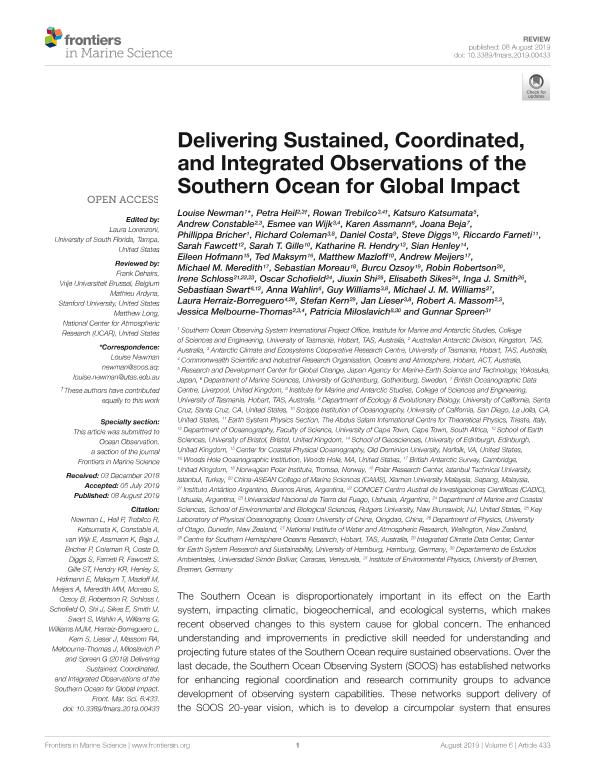Artículo
Delivering sustained, coordinated and integrated observations of the Southern Ocean for global impact
Newman, Louise; Heil, Petra; Trebilco, Rowan; Katsumata, Katsuro; Constable, Andrew J.; Wijk, Esmee van; Assmann, Karen; Beja, Joana; Bricher, Phillippa; Coleman, Richard; Costa, Daniel; Diggs, Steve; Farneti, Riccardo; Fawcett, Sarah; Gille, Sarah; Hendry, Katharine R.; Henley, Sian F.; Hofmann, Eileen; Maksym, Ted; Mazloff, Matthew; Meijers, Andrew J.; Meredith, Michael; Moreau, Sebastien; Ozsoy, Burcu; Robertson, Robin; Schloss, Irene Ruth ; Schofield, Oscar; Shi, Jiuxin; Sikes, Elisabeth L.; Smith, Inga J.
; Schofield, Oscar; Shi, Jiuxin; Sikes, Elisabeth L.; Smith, Inga J.
 ; Schofield, Oscar; Shi, Jiuxin; Sikes, Elisabeth L.; Smith, Inga J.
; Schofield, Oscar; Shi, Jiuxin; Sikes, Elisabeth L.; Smith, Inga J.
Fecha de publicación:
08/2019
Editorial:
Frontiers Media S.A.
Revista:
Frontiers In Marine Science
ISSN:
2296-7745
Idioma:
Inglés
Tipo de recurso:
Artículo publicado
Clasificación temática:
Resumen
The Southern Ocean is disproportionately important in its effect on the Earth system, impacting climatic, biogeochemical, and ecological systems, which makes recent observed changes to this system cause for global concern. The enhanced understanding and improvements in predictive skill needed for understanding and projecting future states of the Southern Ocean require sustained observations. Over the last decade, the Southern Ocean Observing System (SOOS) has established networks for enhancing regional coordination and research community groups to advance development of observing system capabilities. These networks support delivery of the SOOS 20-year vision, which is to develop a circumpolar system that ensures time series of key variables, and delivers the greatest impact from data to all key end-users. Although the Southern Ocean remains one of the least-observed ocean regions, enhanced international coordination and advances in autonomous platforms have resulted in progress toward sustained observations of this region. Since 2009, the Southern Ocean community has deployed over 5700 observational platforms south of 40°S. Large-scale, multi-year or sustained, multidisciplinary efforts have been supported and are now delivering observations of essential variables at space and time scales that enable assessment of changes being observed in Southern Ocean systems. The improved observational coverage, however, is predominantly for the open ocean, encompasses the summer, consists of primarily physical oceanographic variables, and covers surface to 2000 m. Significant gaps remain in observations of the ice-impacted ocean, the sea ice, depths >2000 m, the air-ocean-ice interface, biogeochemical and biological variables, and for seasons other than summer. Addressing these data gaps in a sustained way requires parallel advances in coordination networks, cyberinfrastructure and data management tools, observational platform and sensor technology, two-way platform interrogation and data-transmission technologies, modeling frameworks, intercalibration experiments, and development of internationally agreed sampling standards and requirements of key variables. This paper presents a community statement on the major scientific and observational progress of the last decade, and importantly, an assessment of key priorities for the coming decade, toward achieving the SOOS vision and delivering essential data to all end-users.
Archivos asociados
Licencia
Identificadores
Colecciones
Articulos(CADIC)
Articulos de CENTRO AUSTRAL DE INVESTIGACIONES CIENTIFICAS
Articulos de CENTRO AUSTRAL DE INVESTIGACIONES CIENTIFICAS
Citación
Newman, Louise; Heil, Petra; Trebilco, Rowan; Katsumata, Katsuro; Constable, Andrew J.; et al.; Delivering sustained, coordinated and integrated observations of the Southern Ocean for global impact; Frontiers Media S.A.; Frontiers In Marine Science; 6; 433; 8-2019; 1-31
Compartir
Altmétricas



